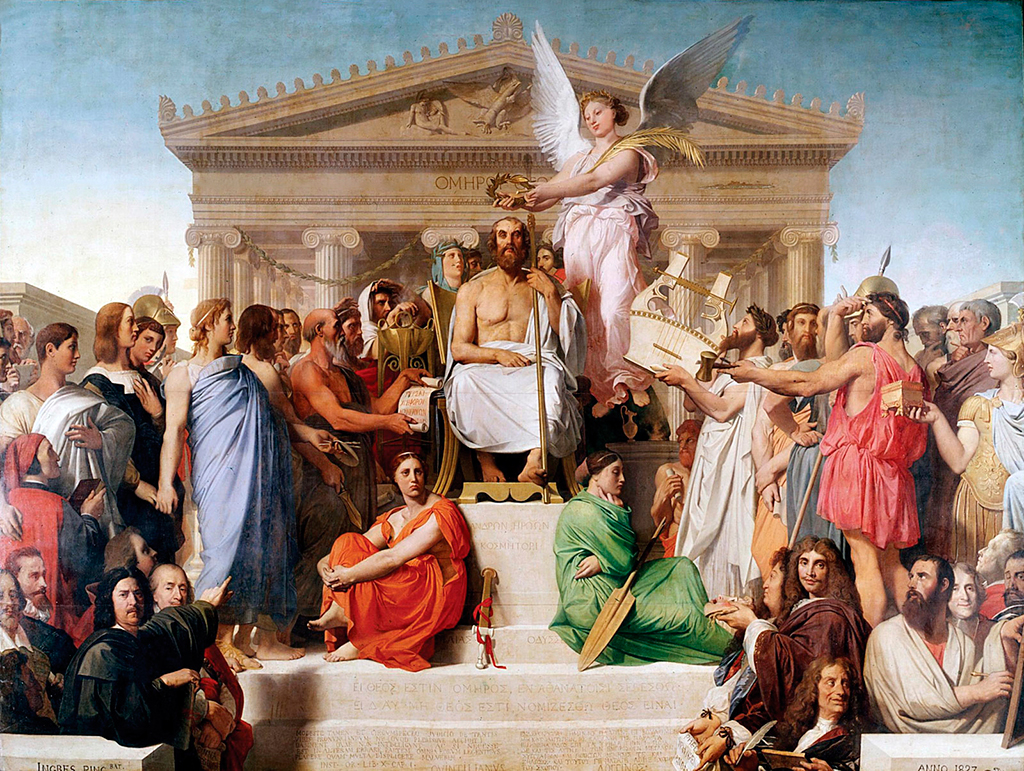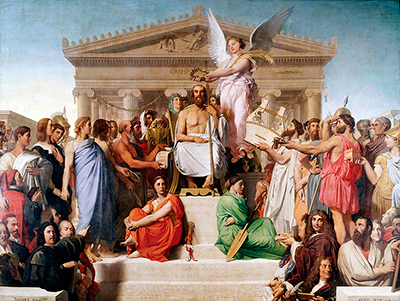The Apotheosis of Homer was certainly one of Jean-Auguste-Dominique Ingres' most complex paintings, featuring his standard use of historical content and exquisite portraiture. His colours were bright and his style was always Neo-Classical.
The Apotheosis of Homer came at a time when the artist was in the minority, stylistically, with most artists in this part of Europe preferring a more Romanticist approach. The Louvre, one of the finest art museums in the world, now displays this stunning artwork which was completed by Inges in 1827. This momentous piece features almost 50 different figures across the wide canvas and it would have taken a considerable amount of time to complete the painting in its entirety. Ingres himself planned his portraits with whole series of study drawings and it is likely that he would have tackled each figure individually before commencing on the final piece. The key figures would have received greater attention, either due to their prominence in the layout of the scene, or their role in the historical narrative.
The scene that we find here is of poet Homer being crowned by a figure who appears to symbolise either Victory or perhaps the Universe. This character is winged. They are joined by a plethora of other figures within this celebration and Ingres carefully arranges them into a symmetrical format which was encouraged by the teachings of traditional art movements. That structure of laying out a composition can also be found in Renaissance sculpture, too. There is an imposing Greek temple which sits in the background and adds further context to the scene. The figures have all since been identified and come from a combination of Greek, Roman and modern times. The full list of figures is included at the bottom of this article.
Raphael was a key influence on Ingres, with the artist studying his work in detail during the many years that he spent living in Italy, most notably Florence, Rome and Naples. This particular artwork is perhaps inspired by Raphael's Parnassus and Ingres' colours are similar to the egg tempera techniques used in frescoes. The French artist was, essentially, attempting to match the beauty of Raphael's work within this painting and well all-out in his preparation in order to ensure that its final quality was as high as he could possibly achieve. Whilst he may not have managed to achieve the fame of Raphael, his work is still of huge importance and influence within the developmeny of European art during his own career.
This painting is possibly the best example of how Ingres placed importance on the values of classical culture, particularly in the arts. He displays it visually here, placing only Raphael and Michelangelo as 'equal' to the great names of ancient times. We are all aware of his love for Neo-Classical styles within his own career but rarely did he visually display it so clearly as he has done here. Sadly, some art critics were more drawn towards several paintings by Delacroix at this time, which they felt were more expressive and dynamic. The Death of Sardanapalus, for example, was displated at the same year's Paris Salon and provided an uncomortable distraction from Ingres' point of view.
Full List of Figures in The Apotheosis of Homer
There is a great variety of cultural icons from all manner of different periods in this scene, including poets, painters, sculptors and philosophers. The arrangement in this painting suggests that the ancient figures were considered by Ingres to be more significant. See the full list below.
- Horace
- Peisistratos
- Lycurgus
- Virgil
- Raphael
- Sappho
- Alcibiades
- Apelles
- Euripides
- Menander
- Demosthenes
- Sophocles
- Aeschylus
- Herodotus
- Orpheus
- Linus
- Homer
- Musaeus of Athens
- Victory or the Universe
- Pindar
- Hesiod
- Plato
- Socrates
- Pericles
- Phidias
- Michelangelo
- Aristotle
- Aristarchus of Samothrace
- Alexander the Great
- Dante
- Iliad personification
- Odyssey personification
- Aesop
- William Shakespeare
- Jean de la Fontaine
- Torquato Tasso
- Wolfgang Amadeus Mozart
- Nicolas Poussin
- Pierre Corneille
- Jean Racine
- Molière
- Nicolas Boileau
- Longinus
- François Fénelon
- Christoph Willibald Gluck
- Luís Vaz de Camões





